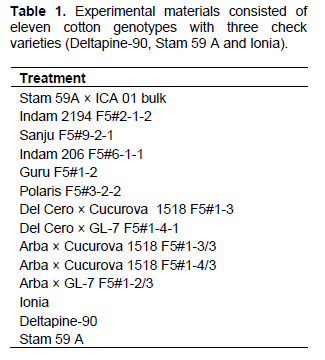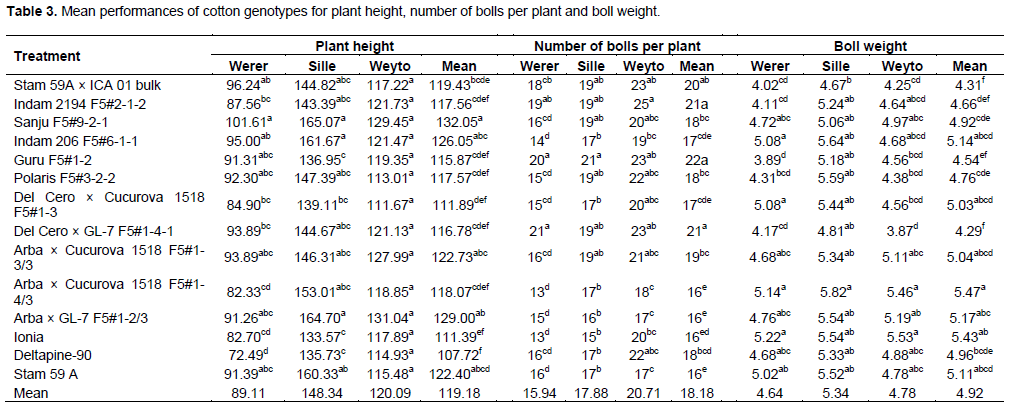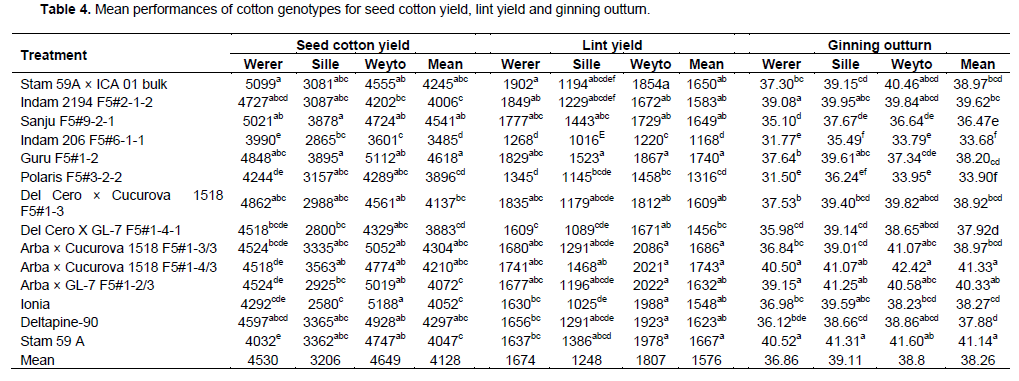Full Length Research Paper
ABSTRACT
The present study was conducted to test the performance of cotton genotypes for yield and yield components from 2011 to 2013 cropping season at different cotton growing agro-ecologies in the country. Eleven cotton genotypes along with three check varieties were examined at three locations in RCBD under three replications. The genotypes manifested highly significant differences (p≤0.01) for plant height, bolls per plant, boll weight, seed cotton yield, ginning outturn and lint yield. The data indicated that higher seed cotton yield, lint yield and ginning outturn were obtained from cotton genotype Arba × Cucurova 1518 F5#1-3/3 at Weyto. Guru F5#1-2 genotype performed higher bolls per plant and seed cotton yield at Weyto but the value of seed cotton yield was lower than that of best performed check varieties. And also, the maximum seed cotton yield was recorded in Stam 59A × ICA 01 bulk and Sanju F5#9-2-1 cotton genotypes at Werer. It is concluded that the higher mean performance of seed cotton yield and more lint yield were obtained in cotton genotypes Guru F5#1-2, Sanju F5#9-2-1 and Arba × Cucurova 1518 F5#1-3/3 than that of check varieties. Moreover, Arba × Cucurova 1518 F5#1-4/3 genotype performed maximum boll weight, ginning outturn and lint yield than the check varieties. Therefore, genotypes Guru F5#1-2, Sanju F5#9-2-1, Arba × Cucurova 1518 F5#1-4/3 and Arba × Cucurova 1518 F5#1-3/3 recommended to use for their performed traits.
Key words: Seed cotton yield, plant height, lint yield, Genotypes, mean performance.
INTRODUCTION
Cotton is the most important fiber crop of Ethiopia. The cotton plant provides raw material to all textile mills, ginning factories, cottage industries and oil mills. It is also used for edible oil production, which when quantified makes a huge contribution to the national oil production (https:// www.cotton.org/pubs/cottoncounts/story/importance.cfm). The crop is also used as an important source of cash for the growers and it offers considerable employment opportunity on the farms, in ginneries, oil mills, and knitting, textile and garment factories. At present, cotton is produced under both rain-fed and irrigated conditions by private commercial farms and small holders. Commercial cotton is produced in the lowland irrigated areas at elevations below 1300 m. The major growing areas are the Upper, Middle and Lower Awash Rift Valley areas in the East, and the Abaya, Arba Minch, Sille, Weyto and Omorate areas in the South part of the country; while the rain-fed cotton production centres are located in the medium altitude ranging from 1000 to 18000 m above sea level, mainly in Gambella, Beneshangul Gumuz, Amhara, Tigray, and SNNP regions. According to a study report of Minister of Agriculture and Rural Development, there are some 3,000,810 ha of land suitable for cotton production, which is far above that of Pakistan, the fourth largest producer of cotton in the world that harvests around 2.5 to 3.5 million tons of cotton per annum. Despite this immense potential, Ethiopia currently produces only about 214,786 tons of seed cotton from a total cultivated land amount of about 111,886 ha which accounts for about 3.7% of the total potential area of the country (Ministry of Agriculture and Rural Development (MoARD), 2010).
Ethiopian cotton productivity is 860 to 1800 kg/ha in rain fed and 2200 kg/ha in irrigated farms. These low yields may be attributed to several factors like poor management practices, diseases and pests and lack of knowhow by growers about the advanced package of technology concerning cotton production. However, most common cause of low productivity in Ethiopia is lack of improved varieties in form of seed cotton yield and yield components. The new variety CIM-608 has been developed through interspecific hybridization, that is, (Gossypium hirsutum × Gossypium anomalum) × G. hirsutum and produced significantly higher yield in varietal trials compared with the standard variety, that is, MNH-786 (Zahid et al ., 2014). Significant differences were observed in yield and yield contributing traits with the development of new varieties of Upland cotton (Singh et al., 1973). Arshad et al. (2003) found significant variation for various characters like ginning out percentage, staple length, number of bolls and boll weight due to the use different genotypes.
Therefore, various parents have been involved in crosses of intraspecific crosses at Werer Agricultural Research Center to improve seed cotton yield and yield components and many of the crosses have passed through a series of evaluations and the best ones are now at the National yield trial and have almost reached homozygosity and the present study was conducted to evaluate these genotypes in form of seed cotton yield and yield components at different cotton growing agro-ecologies of Ethiopia to release as new varieties if found to be superior to the varieties under cultivation.
MATERIALS AND METHODS
The experiment was carried out from 2011 to 2013 main growing season at three locations (Werer, Sille and Weyto) of cotton growing regions. Werer is located at 9° 34’12” N latitude and 40° 17’22”E longitude and 740 m above sea level (masl), Sille is located at 5° 51’42” N latitude and 37° 28’32” E longitude at an elevation of 1120 masl, and Weyto is located at 5° 23’31” N latitude and 36° 58’41” E longitude at an elevation of 550 masl. Eleven cotton genotypes (Table 1) with three check varieties (Deltapine-90, Stam 59 A and Ionia) were obtained from Werer Agricultural Research Center. The experiment was carried out in randomized complete block design with three replications. Sowing was carried out in five rows each 5-m long with plant to plant distance of 20 cm and row to row distance of 90 cm (plot size of 5 m × 5 rows × 0.9 = 22 m2). Three seeds per hole were hand sown on the top of the ridges. Thinning was done fifteen days after emergence to have the required population of 125 plants per plot. Appropriate agronomic practice and field evaluations were also implemented as per the schedule. The central three rows with net plot size of 5 m × 3 rows × 0.9 = 13.5 m2 were used for harvesting seed cotton yield to avoid border effect, and other data were taken from fifteen selected plants from central rows of a plot. Agronomic traits, namely: plant height, number of bolls per plant, mature boll weight (g), seed cotton yield, ginning outturn and lint yield, were collected. The data collected were statistically analyzed according to Steel and Torrie (1984) by using SAS software for analysis of variance (ANOVA).

RESULTS AND DISCUSSION
According to analysis of variance (Table 2), the overall mean values of fourteen cotton genotypes manifested highly significant differences (p≤0.01) for plant height, bolls per plant, boll weight, seed cotton yield, ginning outturn and lint yield. The differences among locations were found significant for all characters while the location × genotype interactions were non-significant for all characters except seed cotton yield and lint yield. Therefore, the results revealed significant variations among the genotypes and locations for all of the traits studied.

Plant height
Data regarding the plant height is shown in Table 3. On average, the plant heights were varied from 107.72 to 132.05 cm among fourteen cotton genotypes. The tallest plant height was observed in Sanju F5#9-2-1 (132.05 cm) followed by Arba × GL-7 F5#1-2/3 (129 cm) and Indam 206 F5#6-1-1 (126.05 cm) genotypes. The shortest plant height was observed in Deltapine-90 (107.72 cm) and it was statistically at par with seven genotypes with plant height from 111.39 to 118.07 cm. The differences among genotypes for plant height might have been due to the difference in genetic makeup of genotypes considered in the experiment. These results are in confirmation with those of Premalatha et al. (2020) and Nikhil et al. (2018) who reported that plant height is affected due to genetic makeup of genotypes.

Bolls per plant
The highest bolls per plant were picked from Indam 2194 F5#2-1-2, Guru F5#1-2 and Delcero × GL-7 F5#1-4-1 cotton genotypes at all locations (Weyto (24.79 bolls plant-1), (23.24 bolls plant-1) and (23.43 bolls plant-1), Sille (18.78 bolls plant-1), (21.29 bolls plant-1) and (18.56 bolls plant-1) and Werer (19.28 bolls plant-1), (20.33 bolls plant-1) and (20.6 bolls plant-1)), respectively. The lowest bolls per plant were picked from Ionia cotton genotype at Werer (13.37 bolls plant-1) and Sille (15.45 bolls plant-1). Overall locations, bolls per plant gave that the maximum value from Guru F5#1-2 (21.62 bolls plant-1) followed by Indam 2194 F5#2-1-2 (20.95 bolls plant-1) and Delcero × GL-7 F5#1-4-1 (20.87 bolls plant-1). Seven genotypes had bolls plant-1 higher than that of the best check variety Deltapine-90 (18.1395 bolls plant-1). The minimum bolls per plant were picked from check variety Stam 59 A (15.72 bolls plant-1) and were found statistically at par with five genotypes (15.93 to 17.31 bolls plant-1) (Table 3). The differences among genotypes for number of bolls per plant might have been due to the difference in genetic potential of the genotypes and environment. The significant differences among varieties for number of bolls per plant had also been reported by Shakeel et al. (2015). The results were also in accordance with the findings of Chaudhari et al. (2017) who also reported variable number of bolls per plant for different genotypes.
Boll weight
Two cotton genotypes (namely, Arba × Cucurova 1518 F5#1-4/3 and Ionia) produced biggest boll weight at all locations (Sille (5.82 g) (5.54 g), Weyto (5.46 g) (5.53 g) and Werer (5.14 g) (5.22 g)). Indam 206 F5#6-1-1 cotton genotype produced biggest boll weight at Sille (5.64 g) and Werer (5.08 g). Delcero × GL-7 F5#1-4-1 (3.87 g) and Guru F5#1-2 (3.89 g) cotton genotypes produced the smallest boll weight at Weyto and Werer, respectively. Average boll weight of the cotton genotypes revealed that the biggest boll weight was noticed in genotypes Arba × Cucurova 1518 F5#1-4/3 (5.47 g) and Ionia (5.43 g), followed by Arba × GL-7 F5#1-2/3 (5.17 g), Indam 206 F5#6-1-1 (5.14 g) and Stam 59 A (5.11 g). The smallest boll weight was noticed in genotypes Delcero × GL-7 F5#1-4-1 (4.29 g) and Stam 59A × ICA 01 bulk (4.31 g). The variation was due to the use of different genotypes. These results are also in line with those of Ahsan et al. (2015) and Farooq et al. (2017) who reported that average boll weight varies significantly among the varieties studied.
Seed cotton yield
In Table 4, it can be seen that the maximum seed cotton yield was recorded in Stam 59A × ICA 01 bulk and Sanju F5#9-2-1 cotton genotypes at Werer (5099 and 5021 kg ha-1) and recorded in Guru F5#1-2, Arba × Cucurova 1518 F5#1-3/3 and Arba × GL-7 F5#1-2/3 genotypes at Weyto (5112, 5052, and 5019 kg ha-1); but there, the results were exceeded by check variety Ionia (5188 kg ha-1). The minimum seed cotton yield was observed at Sille in all varieties, rather than other locations. The overall mean values of seed cotton yield ranged from 3485 to 4618 kg ha-1 among cotton genotypes. The highest seed cotton yield was obtained from Guru F5#1-2 (4618 kg ha-1) and Sanju F5#9-2-1 (4541 kg ha-1) cotton genotypes, followed by Arba × Cucurova 1518 F5#1-3/3 (4304 kg ha-1) and Deltapine-90 (4297 kg ha-1) cotton genotypes. The lowest seed cotton yield was obtained from Indam 206 F5#6-1-1 (3485 kg ha-1) genotype; but was found statistically at par with two other genotypes, whose seed cotton yields were 3883 and 3896 kg ha-1. These results are in line with those of Premalatha et al. (2020) who reported seed cotton yield traits in cotton vary depending on the genotypic structure of cultivar and environmental conditions.
Lint yield
The data pertaining to lint yield is presented in Table 4. The highest lint yield was produced in Arba × Cucurova 1518 F5#1-3/3, Arba × GL-7 F5#1-2/3 and Arba × Cucurova 1518 F5#1-4/3 genotypes at Weyto (namely, 2086, 2022, and 2021 kg ha-1, respectively); and produced in Stam 59A × ICA 01 bulk, Indam 2194 F5#2-1-2, Delcero × Cucurova 1518 F5#1-3 and Guru F5#1-2 at Werer (namely, 1902, 1849, 1835, and 1829 kg ha-1, respectively). Cotton genotypes Indam 206 F5#6-1-1 and Polaris F5#3-2-2 revealed the lowest lint yield at all locations; namely, Sille (1016 and 1145 kg ha-1), Weyto (1220 and 1458 kg ha-1) and Werer (1268 and 1345 kg ha-1), respectively.
On average, the lint yields of the genotypes varied between 1168 and 1743 kg ha-1. The maximum lint yield was observed in Arba × Cucurova 1518 F5#1-4/3 (1743 kg ha-1) and Guru F5#1-2 (1740 kg ha-1) genotypes, followed by genotypes Arba × Cucurova 1518 F5#1-3/3 (1686 kg ha-1), Stam 59 A (1667 kg ha-1), Stam 59A × ICA 01 bulk (1650 kg ha-1) and Sanju F5#9-2-1 (1649 kg ha-1); and the minimum lint yield was observed in Indam 206 F5#6-1-1 (1168 kg ha-1) genotype.

Ginning outturn (%)
The difference between genotypes in the ratio of lint to the seed cotton was analyzed for ginning outturn percentage. In Table 4, it can be seen that cotton genotype Arba × Cucurova 1518 F5#1-4/3 gave the highest ginning outturn at Weyto (42.42%), Sille (41.07%) and Werer (40.5%). However, the entry value at Sille and Werer was nearly equivalent with the best check variety. Arba × GL-7 F5#1-2/3 genotype gave the highest lint percentage at Sille (41.25%); but the entry value was nearly equivalent with check variety Stam 59 A (41.31%). Cotton genotypes Polaris F5#3-2-2 and Indam 206 F5#6-1-1 gave the lowest ginning outturn at Werer (31.5 and 31.77%) and Weyto (33.95 and 33.79%). Overall, lint percentage of the genotypes showed that the highest lint percentage was noticed in genotypes Arba × Cucurova 1518 F5#1-4/3 (41.33%) and Stam 59 A (41.14%) followed by Arba × GL-7 F5#1-2/3 (40.33%) and Indam 2194 F5#2-1-2 (39.62%) genotypes. The lowest lint percentage was noticed in genotypes Indam 206 F5#6-1-1 (33.68%) and Polaris F5#3-2-2 (33.9%). The aforementioned findings are well supported by published results of Nikhil et al. (2018) and Premalatha et al. (2020) who reported differences in the ginning outturn percentage (% GOT) due to differences among varieties. Huseyin et al. (2017) studied the comparison of mean yield components and fiber quality parameters of advanced bulk generations in f2, f3 and f4 interspecific and intraspecific cotton populations, and observed varied ginning % for different genotypes.
CONCLUSION
It can be concluded that considerable variability was observed among traits. The test varieties with high seed cotton yield and lint yield can be recommended for their desirable performance. The genotypes Guru F5#1-2, Sanju F5#9-2-1 and Arba × Cucurova 1518 F5#1-3/3 performed better than the check varieties in terms of both seed cotton and lint yield. Arba × Cucurova 1518 F5#1-4/3 genotype gave maximum boll weight, ginning % and lint yield compared to the check varieties. On the basis of these results, it is recommended that the cotton genotypes Guru F5#1-2, Sanju F5#9-2-1, Arba × Cucurova 1518 F5#1-3/3 and Arba × Cucurova 1518 F5#1-4/3 can be released to be used for their performed traits.
CONFLICT OF INTERESTS
The authors have not declared any conflict of interests.
REFERENCES
|
Ahsan MZ, Laghari MA, Bhutto H, Soomro AW, Majidano MS, Malik TH (2015). Genetic variability in different biometric traits of upland cotton genotypes. International Journal of Biology and Biotechnology 12(4):607-612. |
|
|
Arshad M, Afzal M, Khan MI, Rashid M (2003). Performance of newly developed cotton strains for economic and fibre traits in NCVT. Pakistan Journal of Scientific and Industrial Research India 46(5):373-375. |
|
|
Chaudhari MN, Faldu GO, Ramani HR (2017). Genetic variability, correlation and path coefficient analysis in cotton (Gossypium hirsutum L.). Advances in Bioresearch 8(6):226-233. |
|
|
Farooq J, Rizwan M, Sharif I, Chohan SS, Kainth R (2017). Genetic diversity studies in some advanced lines of Gossypium hirsutum L. for yield and quality related attributes using cluster and principal component analysis. Advances in Agriculture and Botanics 9(3):111-118. |
|
|
Huseyin B, Burcu D, Tunay K, Emre I, Huseyin G (2017). Comparison of mean yield components and fiber quality parameters of advanced bulk generations in f2, f3 and f4 interspecific and intraspecific cotton populations. Turkish Journal of Field Crops 22(1):14-23. |
|
|
Ministry of Agriculture and Rural Development (MoARD) (2010). National Rice Research and Development Strategy of Ethiopia. The Federal Democratic Republic of Ethiopia, Ministry of Agriculture and Rural Development, Addis Ababa, Ethiopia. 48p. |
|
|
Nikhil PG, Nidagundi JM, Anusha HA (2018). Genetic variability and heritability studies for seed cotton yield, yield attributing and fibre quality traits in upland cotton (Gossypium hirsutum L.). Journal of Pharmacognosy and Phytochemistry 7(5):1639-1642. |
|
|
Premalatha N, Mahalingam L, Kumar M, Rajeswari S (2020). Genetic Variability Studies in Gossypium barbadense L. Genotypes for Seed Cotton Yield and its Yield Components. International Journal of Current Microbiology and Applied Sciences 9(6):01-12. |
|
|
Shakeel A, Talib I, Rashid M, Saeed A, Ziaf K (2015). Genetic diversity among upland cotton genotypes for quality and yield related traits. Pakistan Journal of Agricultural Sciences 52(1):73-77 . |
|
|
Singh HG, Mital RK, Upadhyah RK (1973). Variety improvement and interaction in American cotton (G. hirsutum L.) in Uttar Pardesh. Indian Journal of Agricultural Sciences 43(5):463-466. |
|
|
Zahid IA, Muhammad TA, Khezir H, Farzana A, Umbreen S, Muhammad A (2014). Development of high yielding and clcuv resistant ulpand cotton variety "CIM - 608". Pakistan Journal of Phytopathology 26(01):23-32. |
|
Copyright © 2024 Author(s) retain the copyright of this article.
This article is published under the terms of the Creative Commons Attribution License 4.0